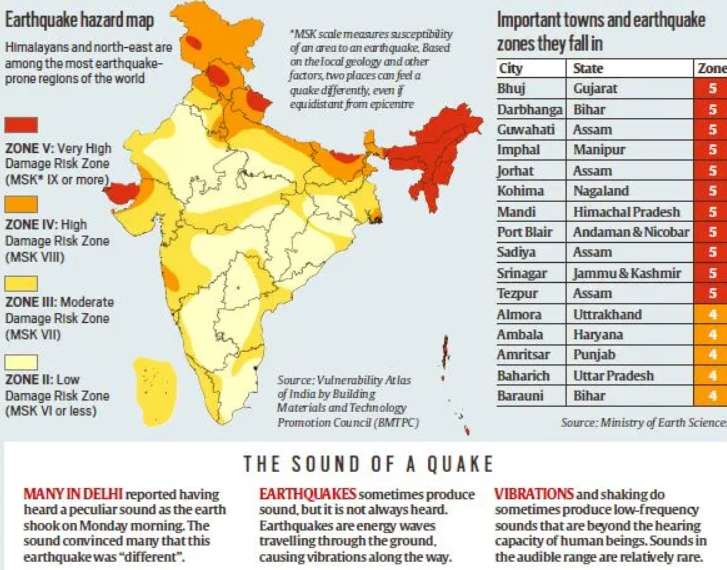Tremors in Delhi vs. Himalayan Earthquakes
Syllabus:
GS 1: Earthquakes
Why in the News?
A magnitude 4 earthquake struck Delhi near Dhaula Kuan, making it the strongest in five years. Delhi’s seismic activity and its location in Zone 4 highlight the need for earthquake preparedness and monitoring.
Earthquake in Delhi: A Rare Event
- Delhi has experienced earthquakes before, but the one on Monday was different.
- Most tremors in the city come from distant regions, such as Afghanistan or the Himalayas.
- This time, the magnitude 4 earthquake originated within Delhi, near Dhaula Kuan.
- It was the strongest earthquake to have originated in Delhi in the past five years.
- A second earthquake of similar magnitude occurred in Siwan, Bihar, a few hours later.
- Since magnitude 4 earthquakes are mild, no major damage was reported.
Seismic Activity in Delhi
- Delhi lies in a seismically active region and is prone to earthquakes.
- Several small earthquakes with magnitudes between 2 and 3 occur in and around the city regularly.
- These minor quakes are usually detected only by seismometers.
- According to the National Centre of Seismology, Delhi falls in Zone 4, a high-risk category in India’s earthquake hazard map.
- Zone 4 regions are expected to experience MSK-8 level intensity during an earthquake.
Understanding MSK Intensity Scale
- The MSK (Medvedev-Sponheuer-Karnik) scale measures earthquake intensity, not magnitude.
- It assesses how an earthquake affects buildings and infrastructure.
- Delhi’s classification under MSK-8 means it is prone to major structural damage.
- The most earthquake-prone areas in India fall under Zone 5, which corresponds to MSK-9 or higher intensity.
Delhi’s Geology: Aravalli-Delhi Fold Belt
- Delhi is part of the Aravalli-Delhi Fold Belt, a seismically active region stretching across Rajasthan, Haryana, and Delhi.
- This belt consists of ancient deformed rock layers that have undergone folding due to geological processes over millions of years.
- These deformations cause stress, which can sometimes be released as earthquakes.
- Unlike the Himalayan region, where earthquakes are caused by tectonic plate collisions, the Aravalli-Delhi Fold Belt has slowed in activity over time.
- Although less active today, some faults remain, leading to occasional mild quakes.
Comparing Earthquakes in Delhi and the Himalayas
- Himalayan Earthquakes: Result from the Indian tectonic plate pushing under the Eurasian plate, building up stress that leads to major earthquakes.
- Delhi’s Earthquakes: Caused by residual stress in the Aravalli-Delhi Fold Belt, leading to occasional mild tremors.
- The Himalayan region experiences frequent high-magnitude quakes, while Delhi’s seismic activity is significantly weaker.
Frequency of Earthquakes in Delhi
- On average, about 25 earthquakes of magnitude 5 or higher occur in and around Delhi annually.
- Among these, around five earthquakes reach a magnitude of 5.
- Most of these are too weak to be felt by people and are recorded only by seismometers.
Unusual Sound During the Earthquake
- Many Delhi residents reported hearing a peculiar sound during Monday’s earthquake.
- Earthquakes generate energy waves that travel through the Earth, causing vibrations.
- These vibrations sometimes produce low-frequency sounds that are inaudible to humans.
- Larger earthquakes may generate audible sounds, though this is rare.
- Sounds associated with earthquakes are often mistaken for structural vibrations from buildings and infrastructure.
Historical Earthquakes in Delhi
- Historical records mention a strong earthquake in Delhi around 1720.
- Another major earthquake was reported in 1803, believed to have damaged Qutub Minar.
- However, new research suggests that the 1803 earthquake likely originated in Srinagar-Devprayag (Uttarakhand) and was merely felt in Delhi.
- Unlike the Himalayan region, Delhi has not witnessed truly destructive earthquakes in recent history.
Risk of a Major Earthquake in Delhi
- Delhi has a history of seismic activity but lacks evidence of high-magnitude earthquakes.
- Scientists believe that Delhi’s tectonic setup does not support large earthquakes.
- The region does not have the necessary energy accumulation or stress required for a devastating quake.
- However, if a major earthquake does occur in a nearby region like the Himalayas, Delhi could experience strong tremors.
- The dense population and urban infrastructure make even moderate earthquakes potentially dangerous.
Earthquake Preparedness in Delhi
- Given Delhi’s high seismic risk, it is crucial to implement earthquake-resistant construction practices.
- Older buildings should be retrofitted to withstand tremors.
- Public awareness campaigns should educate people on earthquake safety.
- Emergency response plans should be strengthened to handle potential disasters.
Conclusion
Delhi experiences frequent mild earthquakes due to its location in the Aravalli-Delhi Fold Belt. While the risk of a major earthquake is low, preparedness, strict building regulations, and continuous seismic monitoring remain crucial for minimizing potential damage and ensuring safety.
Source:
Indian Express
Mains Practice Question:
Discuss the seismic vulnerability of Delhi in comparison to the Himalayan region. How do their geological features influence the frequency and intensity of earthquakes?




